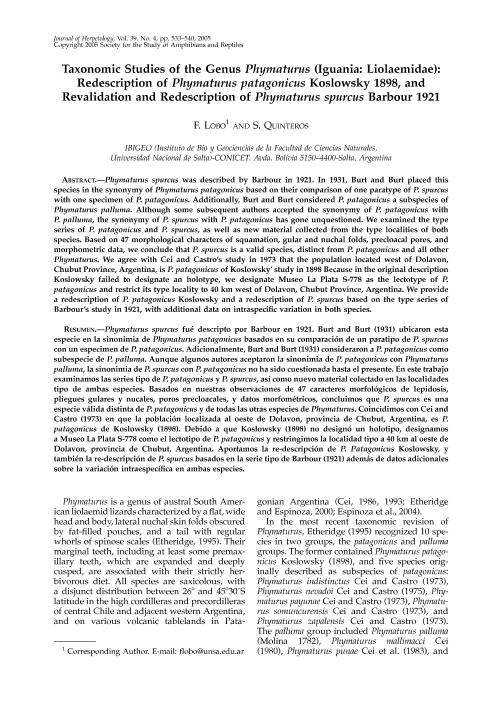Mostrar el registro sencillo del ítem
dc.contributor.author
Lobo Gaviola, Fernando Jose

dc.contributor.author
Quinteros, Andres Sebastian

dc.date.available
2018-08-10T19:27:12Z
dc.date.issued
2005-12
dc.identifier.citation
Lobo Gaviola, Fernando Jose; Quinteros, Andres Sebastian; Taxonomic studies of the genus Phymaturus (Iguania: Liolaemidae): Redescription of Phymaturus patagonicus Koslowsky 1898, and revalidation and redescription of Phymaturus spurcus Barbour 1921; Society for the Study of Amphibians and Reptiles; Journal of Herpetology; 39; 4; 12-2005; 533-540
dc.identifier.issn
0022-1511
dc.identifier.uri
http://hdl.handle.net/11336/54991
dc.description.abstract
Phymaturus spurcus was described by Barbour in 1921. In 1931, Burt and Burt placed this species in the synonymy of Phymaturus patagonicus based on their comparison of one paratype of P. spurcus with one specimen of P. patagonicus. Additionally, Burt and Burt considered P. patagonicus a subspecies of Phymaturus palluma. Although some subsequent authors accepted the synonymy of P. patagonicus with P. palluma, the synonymy of P. spurcus with P. patagonicus has gone unquestioned. We examined the type series of P. patagonicus and P. spurcus, as well as new material collected from the type localities of both species. Based on 47 morphological characters of squamation, gular and nuchal folds, precloacal pores, and morphometric data, we conclude that P. spurcus is a valid species, distinct from P. patagonicus and all other Phymaturus. We agree with Cei and Castro's study in 1973 that the population located west of Dolavon, Chubut Province, Argentina, is P. patagonicus of Koslowsky' study in 1898 Because in the original description Koslowsky failed to designate an holotype, we designate Museo La Plata S-778 as the lectotype of P. patagonicus and restrict its type locality to 40 km west of Dolavon, Chubut Province, Argentina. We provide a redescription of P. patagonicus Koslowsky and a redescription of P. spurcus based on the type series of Barbour's study in 1921, with additional data on intraspecific variation in both species. Copyright 2005 Society for the Study of Amphibians and Reptiles.
dc.format
application/pdf
dc.language.iso
eng
dc.publisher
Society for the Study of Amphibians and Reptiles

dc.rights
info:eu-repo/semantics/openAccess
dc.rights.uri
https://creativecommons.org/licenses/by-nc-sa/2.5/ar/
dc.subject
Phymaturus
dc.subject
Taxonomy
dc.subject
Redescription
dc.subject.classification
Otras Ciencias Biológicas

dc.subject.classification
Ciencias Biológicas

dc.subject.classification
CIENCIAS NATURALES Y EXACTAS

dc.title
Taxonomic studies of the genus Phymaturus (Iguania: Liolaemidae): Redescription of Phymaturus patagonicus Koslowsky 1898, and revalidation and redescription of Phymaturus spurcus Barbour 1921
dc.type
info:eu-repo/semantics/article
dc.type
info:ar-repo/semantics/artículo
dc.type
info:eu-repo/semantics/publishedVersion
dc.date.updated
2018-08-03T15:21:18Z
dc.journal.volume
39
dc.journal.number
4
dc.journal.pagination
533-540
dc.journal.pais
Estados Unidos

dc.journal.ciudad
Salt Lake City
dc.description.fil
Fil: Lobo Gaviola, Fernando Jose. Consejo Nacional de Investigaciones Científicas y Técnicas. Centro Científico Tecnológico Conicet - Salta. Instituto de Bio y Geociencias del NOA. Universidad Nacional de Salta. Facultad de Ciencias Naturales. Museo de Ciencias Naturales. Instituto de Bio y Geociencias del NOA; Argentina
dc.description.fil
Fil: Quinteros, Andres Sebastian. Consejo Nacional de Investigaciones Científicas y Técnicas. Centro Científico Tecnológico Conicet - Salta. Instituto de Bio y Geociencias del NOA. Universidad Nacional de Salta. Facultad de Ciencias Naturales. Museo de Ciencias Naturales. Instituto de Bio y Geociencias del NOA; Argentina
dc.journal.title
Journal of Herpetology

dc.relation.alternativeid
info:eu-repo/semantics/altIdentifier/doi/https://dx.doi.org/10.1670/170-04A.1
dc.relation.alternativeid
info:eu-repo/semantics/altIdentifier/url/http://www.bioone.org/doi/abs/10.1670/170-04A.1
Archivos asociados
